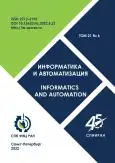Microservice Architecture of Virtual Training Complexes
- Authors: Obukhov A.D1, Volkov A.A1, Nazarova A.O1
-
Affiliations:
- Tambov State Technical University
- Issue: Vol 21, No 6 (2022)
- Pages: 1265-1289
- Section: Digital information telecommunication technologies
- URL: https://journal-vniispk.ru/2713-3192/article/view/267202
- DOI: https://doi.org/10.15622/ia.21.6.7
- ID: 267202
Cite item
Full Text
Abstract
About the authors
A. D Obukhov
Tambov State Technical University
Email: obuhov.art@gmail.com
Sovetskaya St. 106
A. A Volkov
Tambov State Technical University
Email: didim@eclabs.ru
Sovetskaya St. 106
A. O Nazarova
Tambov State Technical University
Email: nazarova.al.ol@yandex.ru
Sovetskaya St. 106
References
- Zahabi M., Abdul Razak A.M. Adaptive virtual reality-based training: a systematic literature review and framework // Virtual Reality. 2020. vol. 24. no. 4. pp. 725-752.
- Saldana D. et al. Applications of head-mounted displays for virtual reality in adult physical rehabilitation: a scoping review // The American Journal of Occupational Therapy. 2020. vol. 74. no. 5. pp. 7405205060p1-7405205060p15.
- Jerdan S.W. et al. Head-mounted virtual reality and mental health: critical review of current research // JMIR serious games. 2018. vol. 6. no. 3. pp. e9226.
- Zulueta A. et al. Virtual reality-based assessment and rating scales in ADHD diagnosis // Psicología Educativa. Revista de los Psicólogos de la Educación. 2019. vol. 25. no. 1. pp. 13-22.
- Alcañiz M. et al. Eye gaze as a biomarker in the recognition of autism spectrum disorder using virtual reality and machine learning: A proof of concept for diagnosis // Autism Research. 2022. vol. 15. no. 1. pp. 131-145.
- Obukhov A.D. et al. The study of virtual reality influence on the process of professional training of miners // Virtual Reality. 2022. pp. 1-25
- Drossis G., Birliraki C., Stephanidis C. Interaction with immersive cultural heritage environments using virtual reality technologies // International Conference on Human-Computer Interaction. Springer, Cham. 2018. pp. 177-183.
- Shinde P.P., Shah S. A review of machine learning and deep learning applications // 2018 Fourth international conference on computing communication control and automation (ICCUBEA). IEEE. 2018. pp. 1-6.
- Qi X. et al. Applying neural-network-based machine learning to additive manufacturing: current applications, challenges, and future perspectives // Engineering. 2019. vol. 5. no. 4. pp. 721-729.
- Delazio A. et al. Force jacket: Pneumatically-actuated jacket for embodied haptic experiences // Proceedings of the 2018 CHI conference on human factors in computing systems. 2018. pp. 1-12.
- Andrews C. et al. Extended reality in medical practice // Current treatment options in cardiovascular medicine. 2019. vol. 21. no. 4. pp. 1-12.
- Obukhov A. et al. Methodology for the Development of Adaptive Training Systems Based on Neural Network Methods // Proceedings of the Computational Methods in Systems and Software. Springer, Cham. 2021. pp. 238-253.
- Tapia F. et al. From monolithic systems to microservices: A comparative study of performance // Applied sciences. 2020. vol. 10. no. 17. p. 5797.
- Niknejad N. et al. Understanding Service-Oriented Architecture (SOA): A systematic literature review and directions for further investigation // Information Systems. 2020. no. 91. p. 101491.
- Cerny T., Donahoo M.J., Trnka M. Contextual understanding of microservice architecture: current and future directions // ACM SIGAPP Applied Computing Review. 2018. vol. 17. no. 4. pp. 29-45.
- Rushani L. et al. Differences between Service-Oriented Architecture and Microservices Architecture // International Journal of Natural Sciences: Current and Future Research Trends. 2022. vol. 13. no. 1. pp. 30-48.
- Maurya R. et al. Application of Restful APIs in IOT: A Review // Int. J. Res. Appl. Sci. Eng. Technol. 2021. vol. 9. pp. 145-151.
- Taibi D., Lenarduzzi V., Pahl C. Architectural patterns for microservices: a systematic mapping study // CLOSER 2018: Proceedings of the 8th International Conference on Cloud Computing and Services Science; Funchal, Madeira, Portugal, 19-21 March 2018. SciTePress. 2018.
- Li S. et al. Understanding and addressing quality attributes of microservices architecture: A Systematic literature review // Information and software technology. 2021. vol. 131. pp. 106449.
- Cerny T. et al. On code analysis opportunities and challenges for enterprise systems and microservices // IEEE Access. 2020. vol. 8. pp. 159449-159470.
- Velepucha V., Flores P. Monoliths to microservices-Migration Problems and Challenges: A SMS // 2021 Second International Conference on Information Systems and Software Technologies (ICI2ST). IEEE. 2021. pp. 135-142.
- Городничев М.Г., Полонский Р.В. Оценка возможности использования микросервисной архитектуры при разработке пользовательских интерфейсов клиент-серверного программного обеспечения // Экономика и качество систем связи. 2020. № 3 (17). С. 33-43.
- Bogner J. et al. Microservices in industry: insights into technologies, characteristics, and software quality // 2019 IEEE international conference on software architecture companion (ICSA-C). – IEEE, 2019. pp. 187-195.
- Auer F. et al. From monolithic systems to Microservices: An assessment framework // Information and Software Technology. 2021. vol. 137. pp. 106600.
- Huang L., Zhang C., Zeng Z. Design of a public services platform for university management based on microservice architecture // Microsystem Technologies. 2021. vol. 27. №. 4. pp. 1693-1698.
- Krasnyanskiy M.N., Obukhov A.D., Dedov D.L. Control System for an Adaptive Running Platform for Moving in Virtual Reality // Automation and Remote Control. 2022. Т. 83. №. 3. С. 355-366.
- Obukhov A. et al. Mobile Simulator Control System for Isolating Breathing Apparatus of Software-Hardware Platform // International Journal of Interactive Mobile Technologies. 2020. Т. 14. №. 8. С. 32-42.
Supplementary files









